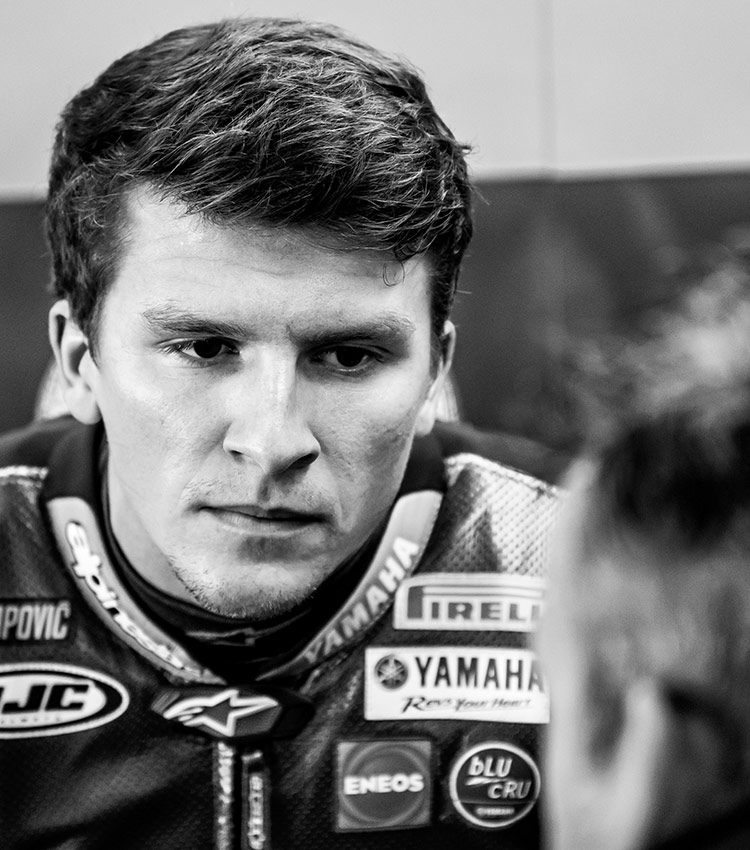Photo courtesy of Yamaha Racing
Racing Feature
Forging His Own Path
American Garrett Gerloff Seeks Overseas Success In World Superbike
By Steve English
Garrett Gerloff had a great job in a comfortable, familiar environment. And he was successful—one of the best, in fact. Yet, the 25-year-old Texan packed up and moved overseas, far from family and friends, to chase his dream of becoming a world champion.
Gerloff left the factory Yamaha Superbike squad in the MotoAmerica Series for the Superbike World Championship with the GRT Yamaha WorldSBK Junior Team.
“Life is an adventure,” Gerloff said when asked why. “You’ve got to have no regrets. You want to be able to tell your kids you did everything you could to live your dream.”
Gerloff turned up a year ago at Magny-Cours in France with helmet in hand. He was a four-time MotoAmerica Superbike race winner and a two-time Supersport national titlist, but he wasn’t a serial premier-class champion like his Yamaha teammate, Cameron Beaubier.
Gerloff was out to prove he had the skills to race with the best on the world stage.
“I’ve been coming to Europe a lot the last few years,” he said. “I’ve gone to races to meet people. I’ve worked hard to prepare myself as best as I could, because I knew I wanted to end up here.
“I tried to do everything in advance. I learned Spanish. That has helped me a ton with day-to-day stuff and being able to have friends outside of racing.
“Whether it happened or not didn’t matter. I knew that if I didn’t prepare, the chance of it happening was small. But, if I did prepare, at least the chance was bigger that it would happen.”
Gerloff’s hard-working nature and desire to race in Europe was well-known to the World Superbike paddock long before his future in the series was confirmed. Dedication, however, doesn’t earn respect in racing. At this level, it is a given.
Motocross Beginnings
Gerloff was a reluctant road racer.
“I tried to play other sports like baseball,” he said, “but I was horrible. I was the last batter. I was in the outfield, where I couldn’t cause any problems. I always loved bikes. My dad was a motocross guy, and I wanted to do that.
“I always thought road racing was a gentleman’s game. I wanted to be on a dirt bike, like my dad. When he got some bad injuries, he started to think road racing could be a better way to go.”
Twelve-year-old Gerloff loved to ride his motorcycle, but he didn’t enjoy racing.
“We were living in Alabama, 20 minutes from Barber Motorsports Park,” Gerloff recalled. “We went to a race, and my dad came back with a 600 and some leathers. He bought everything at the track.
“I was still against it. I wanted to race on the dirt and be in a ‘man’s sport.’ But when my brother got a small bike and I tried it, I just loved it. We sold all our dirt bikes, and I became a road racer.”
Gerloff made the switch to 600cc machinery at age 16 and worked his way to the top of the class. The transition to Superbike in 2018 wasn’t easy, but Gerloff was fast and became a podium contender. The following year, he made a big step.
A threat to Beaubier from the beginning of the 2019 season, Gerloff claimed his first Superbike victory midseason at Laguna Seca. His confidence was high, and he was arguably the fastest rider in the series in what became a straight-up battle between the Yamaha duo.
“There have always been moments in my career where things just click and, bam, things are different,” Gerloff said. “Suddenly, I would be on a different level. That is what I imagine happening in World Superbike.”
The 2020 Effect
“This year has been so weird,” Gerloff said. “I have never gone four months without riding my race bike. We have had tests and track time, but I lacked race time. Overall, I have been pretty happy with what we have been able to do.
“I don’t feel like I’m that far off, but then, at times, I feel like I am pretty far off. It’s strange, because I feel that I have been consistent. It is hard to adapt to World Superbike because the Pirelli tire is so different than the Dunlop.”
MotoAmerica Superbike rules are roughly the same as in the world championship, which has accelerated Gerloff’s adaptation. The biggest challenges, he said, have been understanding the tires and trying to learn from the other Yamaha riders.
“I have ridden Dunlop tires since I was 14,” he said, “so I have a lot of muscle memory for how those tires react. They are a different character, compared to the Pirelli.
“The Dunlop doesn’t have as much initial grip, but it is more stable in the race and doesn’t drop off as much. The Pirelli has a lot more initial grip, but the drop off is more significant. The Pirelli has bigger extremes, with more grip at the start and less at the end.”
Gerloff acknowledged that he needs to learn how to take advantage of that grip.
“The first couple of laps, I lose too much time,” he said.

▲ Gerloff will return to the GRT Yamaha WorldSBK Junior Team in 2021. “This year has been incredible,” he said. “The people I work with on the team are exceptional, so to be able to continue with them is fantastic.”
Photo by Steve English
Working with Graves Motorsports in MotoAmerica provided Gerloff with valuable experience on a top-level team.
“I understand how a factory team works,” he said. “GRT is a top-level team, too, so I feel like I just moved to a similar team. I am not lost within the team, because the dynamics are similar.”
And the other riders on the track?
“I am able to study the data of the other Yamaha riders,” Gerloff said. “I can see what they are doing and use their data to get better. In practice at Phillip Island in Australia, I saw Michael van der Mark and Toprak Razgatlıoğlu were spinning [the rear tire] a lot. With every session, I was trying to work on steering the bike with the rear like they do.
“I was getting better and better, and I was close to matching what they were doing. Then, we got to the race, and they changed their style completely. Suddenly, they weren’t sliding, and I was. I was spinning so much that I destroyed my tire. Pirelli came to me after and said I lost 1 kilogram of rubber in the race. I dropped like a stone, but you’ve got to learn by doing stuff wrong, too.”
Learning from mistakes is an important part of the education process. Finding shortcuts helps. In MotoAmerica, Gerloff arrived at a track with a clear understanding of what he needed. This year, he had to learn on the fly and adapt to different tracks, tires and changes to the electronics package.
Finding the root of a problem is a constant challenge.
“Between rounds, I train with many fast riders,” Gerloff said. “With a Superbike, many things need to be right to go fast, but when I ride supermoto or motocross with other guys, I see that I am fast. That gives me a lot of confidence.
“When I come to the track on the Superbike, I just need a little something. I haven’t been able to figure out exactly where it can come from. It is hard to dial in what I need to change and what I need to change on the bike to get everything to line up.
“Conditions are so different from the morning to the afternoon. Track temperature changes so much throughout the day. If it’s cool in the morning, the grip can be so different that you have to ride differently in the afternoon. That takes time to learn and understand.”
Carving Out a Spot
Gerloff’s speed, consistency and demeanor have impressed the paddock, but the world championship is a tough nut to crack. The 2020 campaign has been one of the most competitive in recent memory, with three manufacturers—Ducati, Kawasaki and Yamaha—winning races.
Gerloff has gone from a big fish in a small pond to a small fish swimming upstream. He is battling riders with years of experience on Pirelli rubber at European circuits. When opportunities present themselves, he has to make the most of those moments.
A deep field doesn’t scare Gerloff.
“After Australia, I expected to get a couple of weeks at home, but that became four months because of COVID-19,” he said. “I felt lost at that stage because I just wanted to get back to racing.
“I’ve worked a lot with Niccolò Canepa because he analyzes all the Yamaha riders. I always have questions for him. After every weekend, the team sits down, and we look at what we did and what we should have done. I am learning a lot, but I want more.
“The atmosphere within the team has been so good. It really feels like a family, and they are always trying to help. If you have a bad day, they are there to pick you up, and that is important.”
Gerloff is a fast learner. Within six rounds of his international debut, at Circuit of Barcelona-Catalunya in Spain, he claimed his first podium, a third in the second of two 20-lap races behind the factory Ducati of Chaz Davies and Yamaha raced by Michael van der Mark.
While this has been a disjointed season, easy to feel isolated, Gerloff has shown he deserves a place on the grid. In October, the GRT Yamaha WorldSBK Junior Team announced Gerloff will remain with the Italian squad through the 2021 season.
“Garrett has shown this year that he is capable of fighting at the front, even at tracks he is not familiar with,” said Andrea Dosoli, Yamaha Motor Europe road racing manager. “So, we are excited to see what he can do next season on the 2021-specification Yamaha YZF-R1 and with a strong team behind him.”
Now, Garrett Gerloff needs to make another step.




